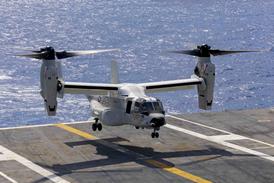US Navy (USN) budget documents reveal that the service plans to retire the newest variant of an unmanned helicopter it spent more than a decade and nearly $1.5 billion developing.
The Northrop Grumman MQ-8C Fire Scout was to perform a range of surface warfare, airborne mine countermeasures, and intelligence, surveillance and reconnaissance (ISR) missions from the decks of Littoral Combat Ships (LCS).
But the USN now wants to mothball the helicopters, according to the service’s fiscal year 2025 budget request, which earmarks no funding for the 36 MQ-8Cs the service has acquired. “Operational employment of the MQ-8C will end in Q4 FY2024 and sundown will be completed by Q4 FY2026,” according to the documents. The US government’s fiscal year 2024 ends in September.

The decision comes just more than two years after the long-delayed MQ-8C’s first operational deployment on the USS Milwaukee (LCS-5) in mid-December 2021. Since then, despite high hopes for the programme, MQ-8Cs have rotated on detachments aboard only four LCS, and only two of the type are currently on detachment, with Independence-class LCS.
“You’re looking at 12 detachments out on these ships,” in total, says Commander Ian Adams, MQ-8C resource officer for the navy’s Air Warfare Division.
That is a limited return for the programme, which began in 2012, at which time leaders expected the aircraft to be operationally available in late 2014.
Derived from Bell’s manned model 407, the unmanned MQ-8C did not achieve initial operational capability (IOC) until summer 2019. Originally intended to provide naval ships with defensive firepower using BAE Systems’ Advanced Precision Kill Weapon System (modified 70mm Hydra rockets fitted with guidance systems), the USN shifted the MQ-8C’s mission to be airborne surveillance and targeting in 2018, delaying IOC.
The service had originally planned to buy 177 MQ-8Cs for $3.47 billion, but in the end acquired only 38, of which two have already been struck from service.
That leaves the USN with 36 MQ-8Cs, though only 17 of those are operational, according to budget documents. Of the remaining 19, two are assigned to the USN’s Air Test and Evaluation Squadron Two Four at Webster Field in Maryland, and 17 are already in storage at the Naval Air Warfare Center Weapons Division in Point Mugu, California.
Asked why the service is retiring a capability it referred to as “a pillar in the navy and Marine Corps unmanned campaign plan” as recently as May 2022, Adams says the decision is rooted in cost versus capability.
“If you look at Fire Scout right now, it’s sitting around $28 million per copy. I can do the same mission with a $100,000 to $250,000 piece of gear. That’s what has changed – the maturation of group 3 UAV systems since that time.”

Group 3 unmanned aerial systems (UAS) are vehicles weighing less than 599kg (1,320lb) and that fly slower than 250kt (463km/h), like the Boeing Insitu RQ-21 Blackjack now in service with the USN and US Marine Corps for ISR missions.
But Adams says the USN currently has no unmanned aircraft available to replace capabilities the service will lose when it retires its MQ-8Cs this autumn. Industry-developed Group 3 UAS “that are 4X more-capable than current group 3 [UAS]” are being evaluated now, he adds. “In concert with our industry partners, we look forward to flight-based testing at the end of this year.”
Manned aircraft, including Sikorsky MH-60s, will have to pick up the slack, Adams says. “We only have two [MQ-8Cs] out on deployment, so we think it’s reasonable that the MH-60s can cover-down on the two that are actually deployed. Those two [MQ-8Cs] are all we’ve been required to field.”
However, the USN’s Constellation-class frigates – originally intended to achieve operational capability in 2026 but now delayed until 2029 – are actually being designed to carry MQ-8Cs.
“The system is being built into the Constellation-class frigate design, most notably the USS Constellation (FFG-62), as well as other ship classes,” Captain Dennis Monagle, who leads the USN’s Multi-Mission Tactical Unmanned Aerial Systems programme office that oversees MQ-8C, said in May 2022.
The MQ-8C retirements leave unclear how or if the USN will attempt to replace on its Constellation-class frigates the autonomous capabilities that the MQ-8Cs were to have provided, but Adams suspects relatively cheap “attritable” unmanned aircraft will fill the void.
“Realistically, with the [frigate] being delayed, I think we’ll find ourselves with these affordable, attritable, connected UAS,” Adams says, “that would team with our MH-60R aboard those ships.”














































